4
Dr. Alicia Walker
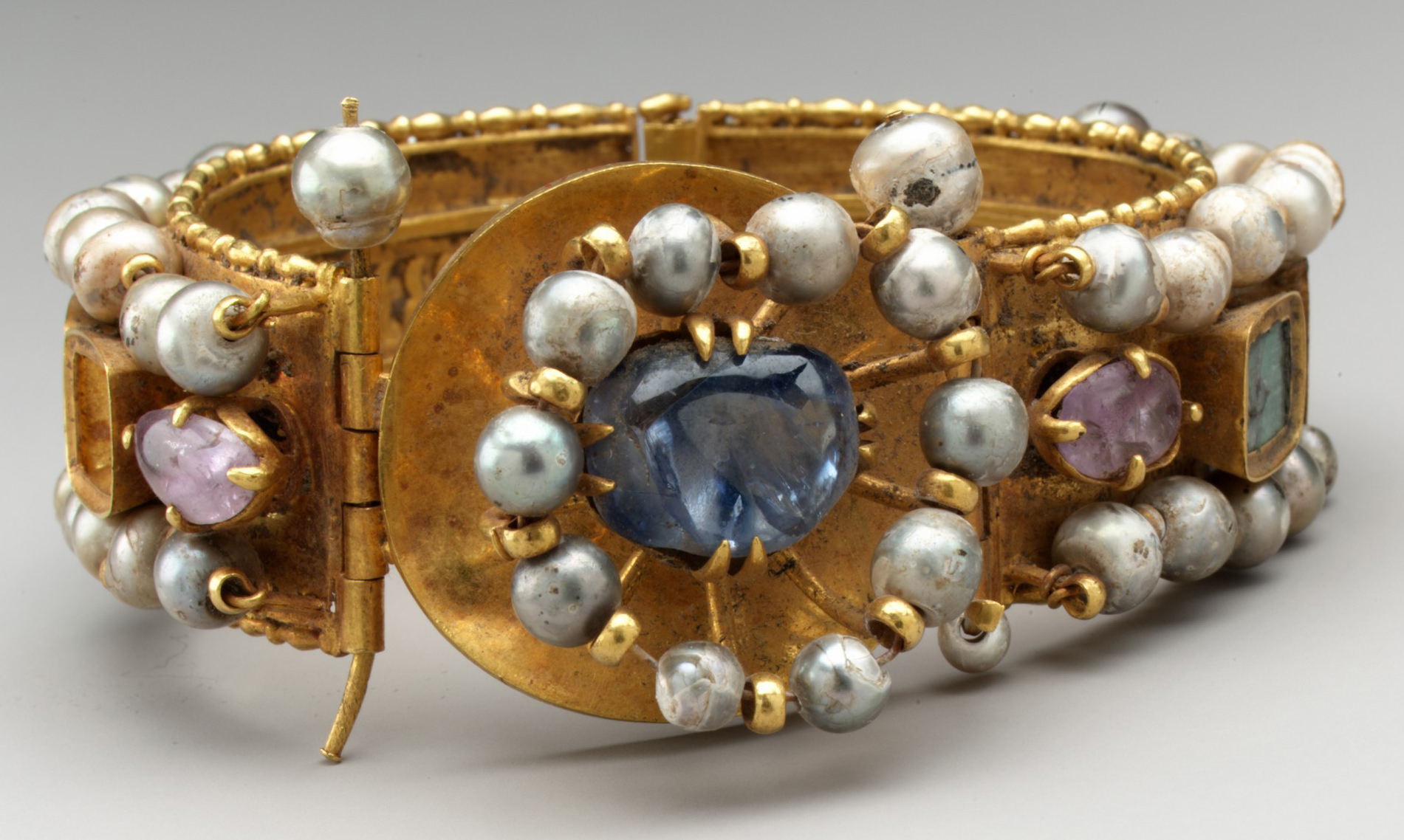
Today, works of Byzantine art are typically encountered in museum settings, divorced from their original contexts of use. For this reason, it is often easy to forget that these objects once participated actively in Byzantine life. This is especially true of things worn on the body. Earrings, bracelets, belts, necklaces, and garments were meant to be seen in motion, changing their appearance as they refracted light, as they were concealed and revealed on the body, and as their wearers—both women and men—engaged in every day and ritual practices. The function of clothing and jewelry was not simply utilitarian: wearable art in Byzantium communicated complex messages about social identity, religious beliefs, and concerns about physical and spiritual well-being.

*
Byzantine bling: Materials, techniques, and aesthetics of adornment
The Byzantines inherited a well-developed tradition of physical adornment from ancient societies, including technologies for cultivating plants and animals that yielded fibers for weaving textiles; sourcing and working natural materials like metals, pearls, and gems; and engineering the production of synthetic materials like glass and enamel. (Enamel is a decorative technique in which glass, colored with metallic oxides, is melted and fused with metal. The Byzantines are well known for their cloisonné enamels, which employ strips of gold—cloisons—to create cells that are filled with glass and fired.) Indeed, some objects combined precious natural materials with those that were human made, like an early Byzantine gold bracelet at The Metropolitan Museum of Art set with pearls, sapphires, emeralds, and amethysts but also glass (see image above). Pearls were harvested from the sea and were typically small in size. They were often strung and applied as framing elements on clothing and jewelry. Precious gems—such as sapphires, amethysts, and emeralds—were imported from throughout medieval Afro-Eurasia and were prized for their color and shape. The Byzantines did not practice faceting. (Faceting is the technique of cutting the surfaces of stones to increase their refraction of light, thereby enhancing their color and luminosity.) Instead, gems were smoothed and polished to enhance their color and luminosity. Gems and semi-precious stones were also engraved and carved in relief, as seen with an engraved intaglio seal with the Crucifixion and a carved cameo with Saint George (reproduced below). Natural gems of comparable size and shape were especially prized.
Earrings or bracelets of matching design or necklaces with regular, repeating elements imposed symmetry on the wearer’s body. The Byzantines celebrated well-proportioned and balanced physical features, and objects of adornment that enhanced these qualities were especially desirable. [1]
More refined examples of Byzantine jewelry often incorporated gold and silver, which were manipulated in complex ways such that these objects conveyed their value in terms of both materials and craftsmanship.
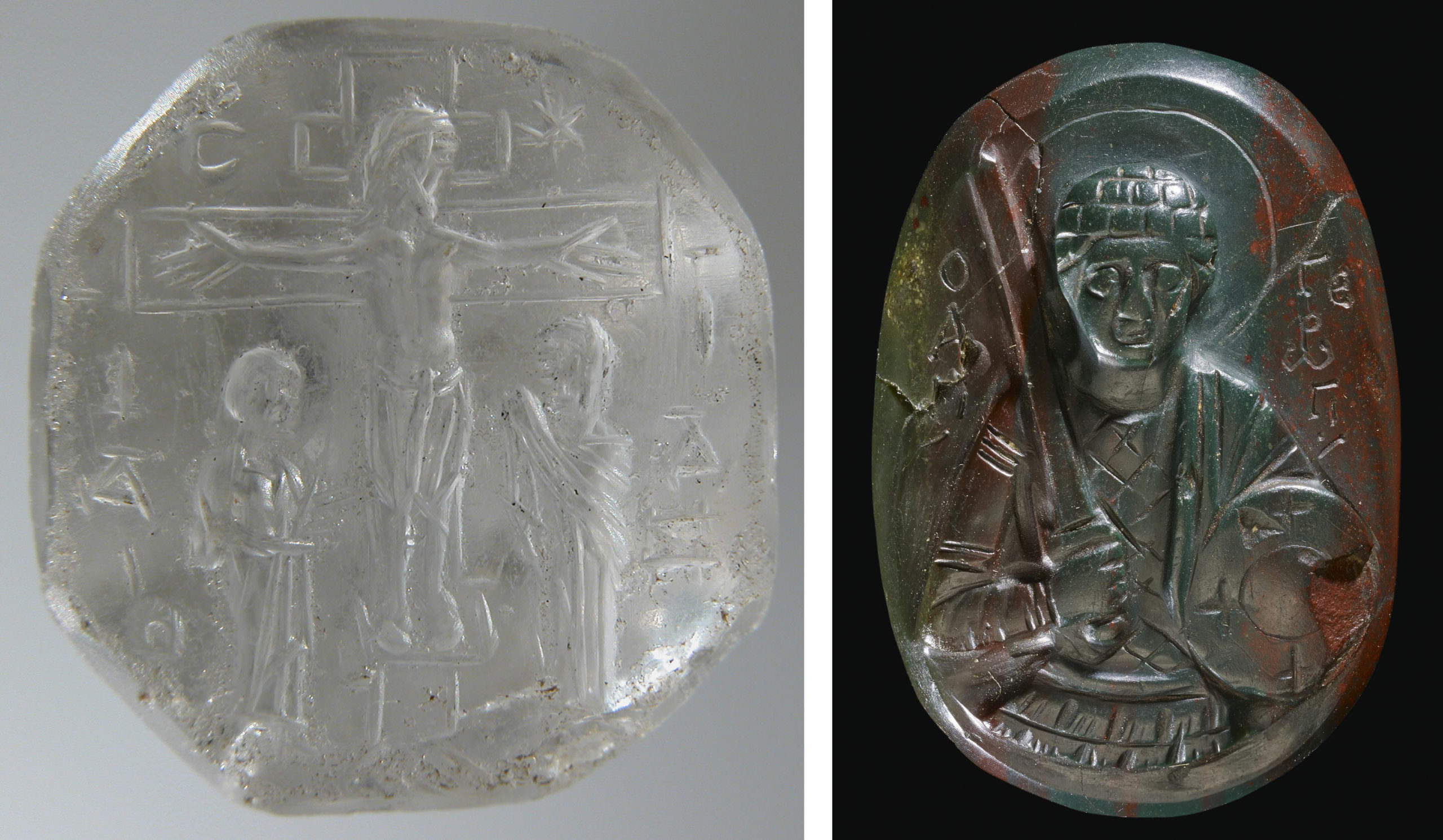

This delicate pair of tenth- or eleventh-century gold basket earrings concentrate in their small forms several demanding techniques of metalworking, including granulation (a technique in which a surface is covered with spherules or granules of precious metal) and filigree (wirework involving the twisting of thin metal threads into intricate lace-like patterns). Through their mastery of these and other techniques, Byzantine artisans created earrings, rings, necklaces, belts, and bracelets of astounding fineness and intricacy.
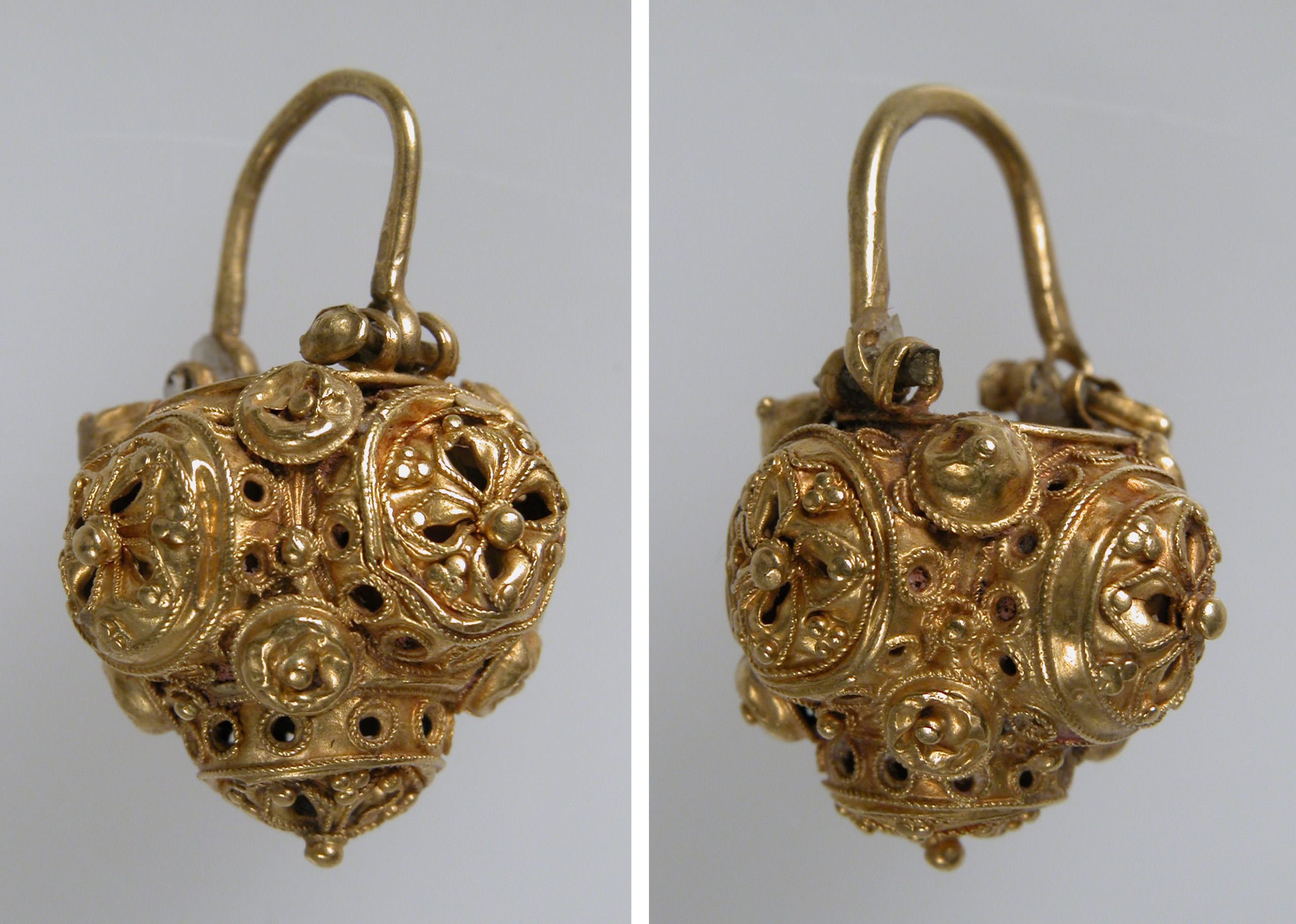
Metal jewelry was also cast (a process by which molten metal is poured into a mould to produce an object’s shape and decoration) and subsequently decorated by means of engraving; repoussé (a technique that involves pressing metal on its reverse surface with the application of force and tools to create patterns and designs in relief by expanding the metal); chasing (a technique that involves pressing metal on its front surface with the application of force and tools to create sunken patterns and designs by compressing the metal); and punching (either the use of tools—punches—as part of repoussé and chasing to manipulate metal in relief and recess; or the use of tools to create holes as part of a metalwork design).
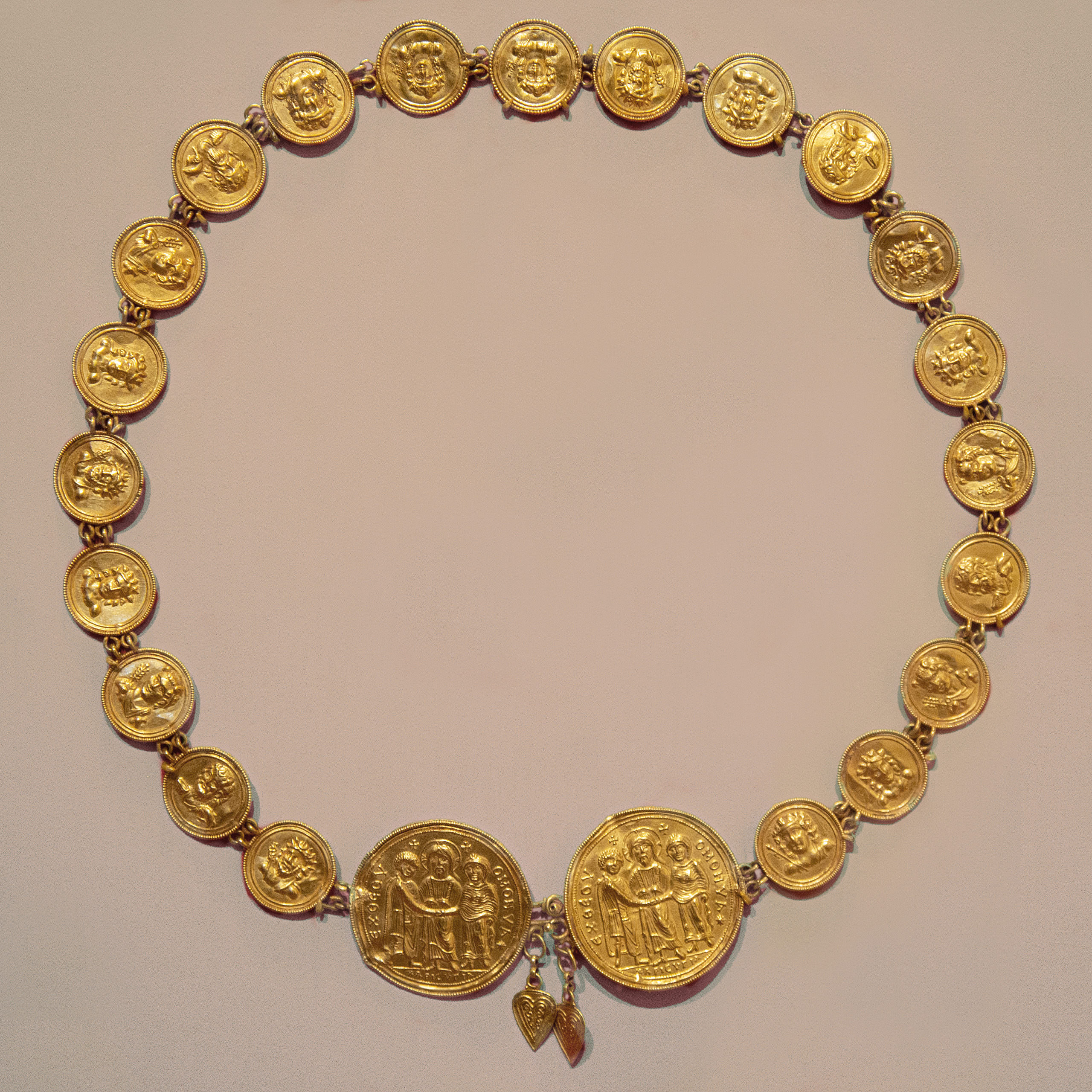
Byzantine metalworkers were especially skilled in the refined form of punching known as opus interrasile (“work [shaped] between”), which involved delicately piercing metal sheets to create fine patterns.
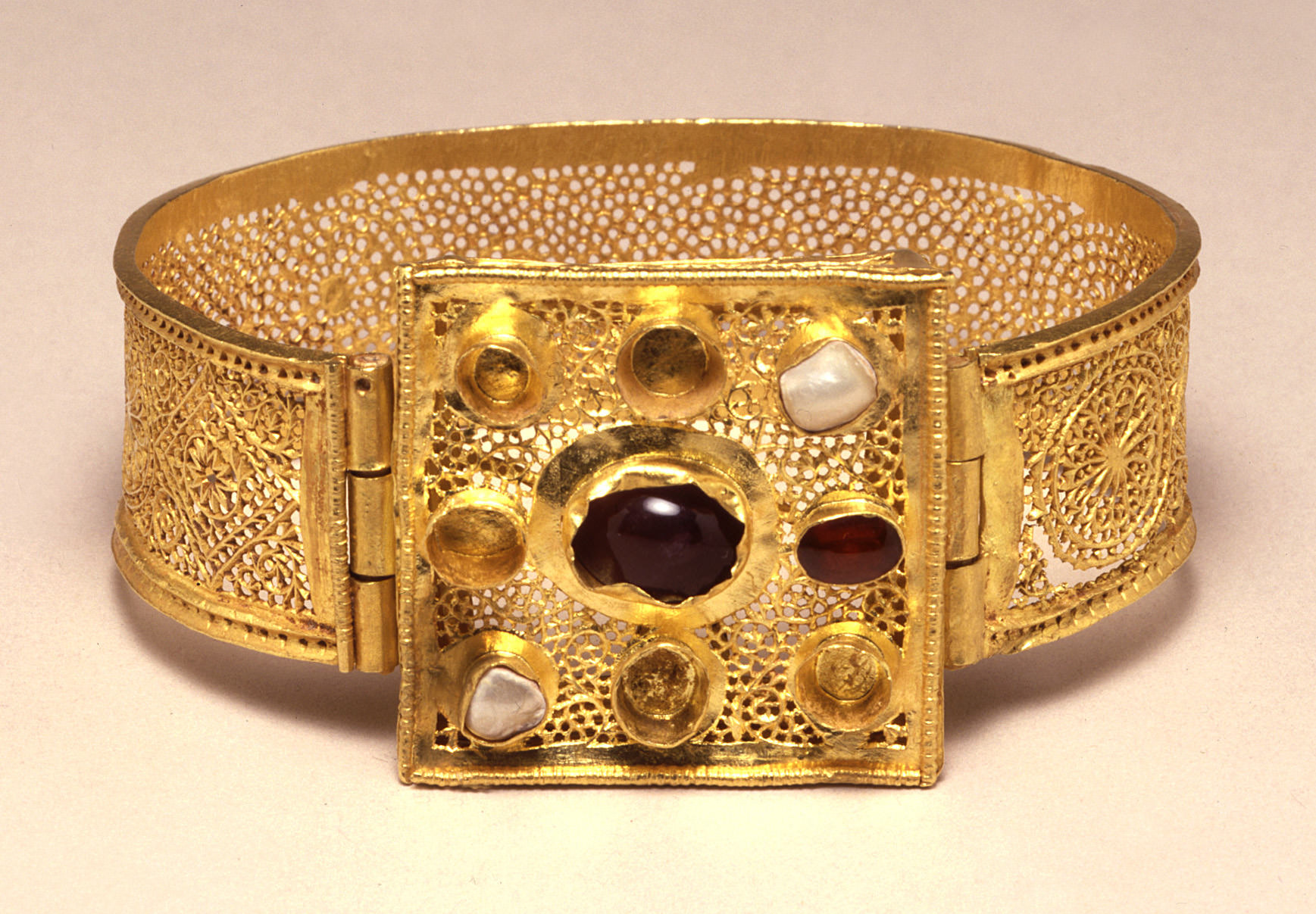
*
*
*
*
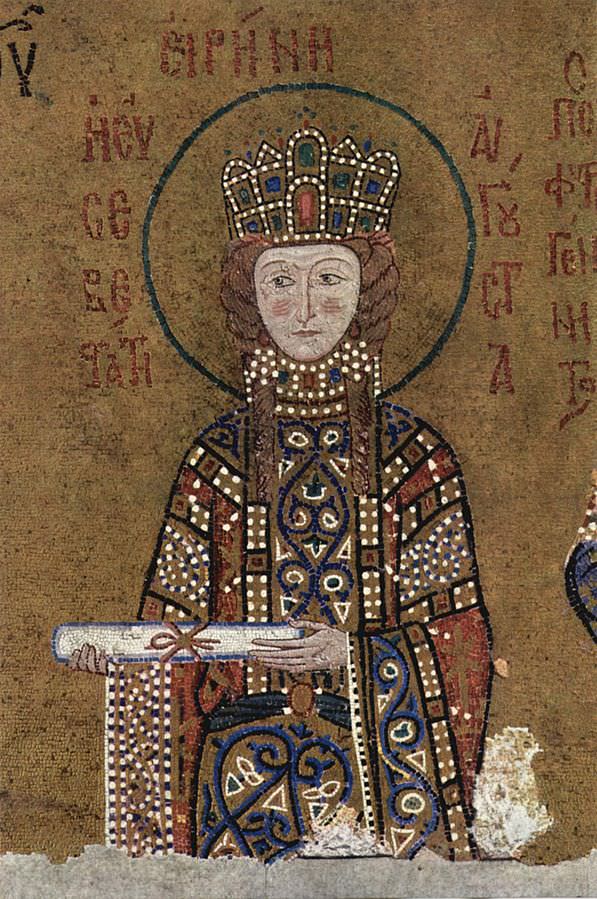
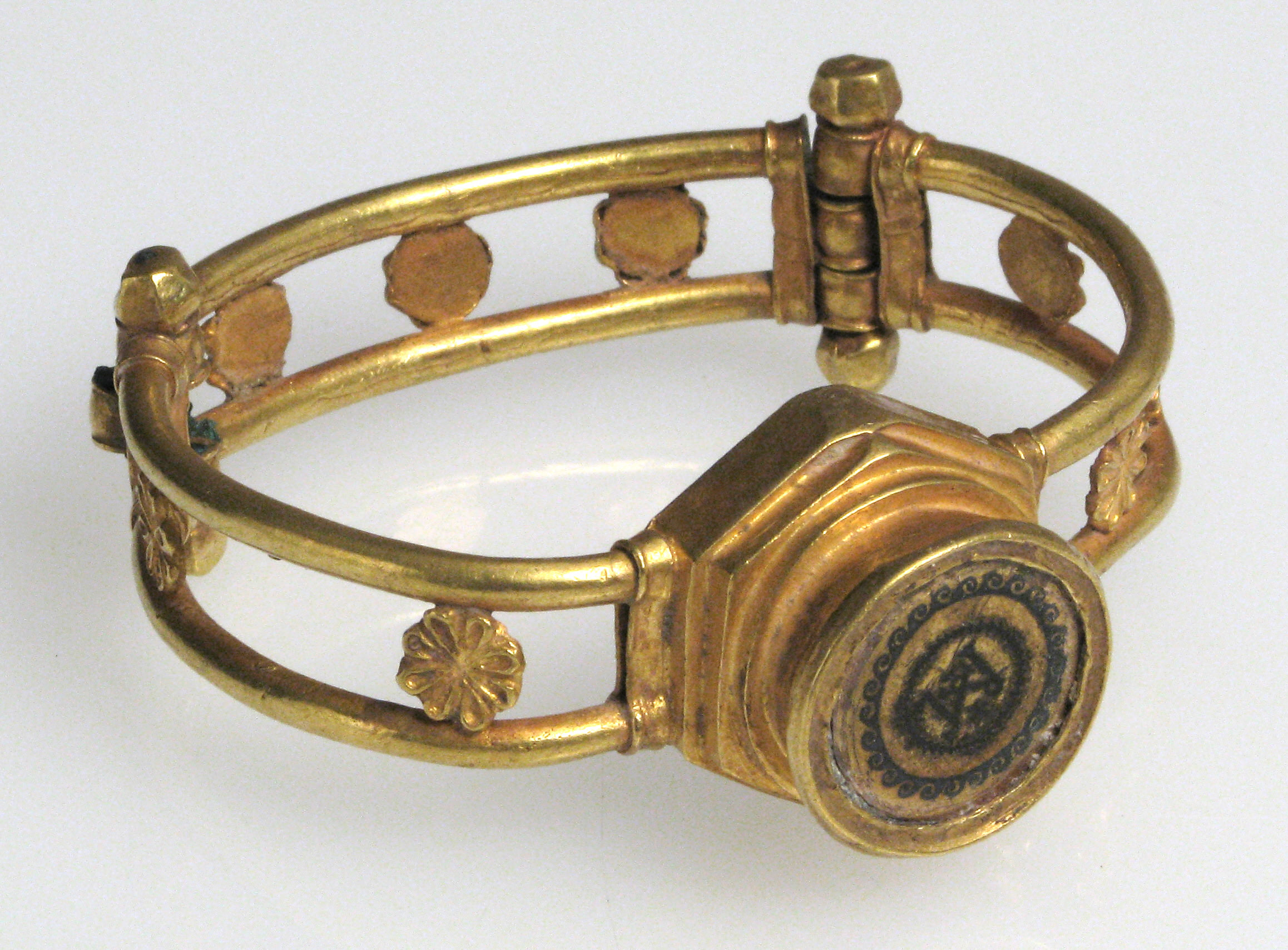
Niello—a chemical alloy that highlights decorative patterns by rendering engraved areas of metal black through oxidization—was used to highlight patterns and inscriptions, as in this Early Byzantine bracelet (above) engraved with the owner’s monogram and this Middle Byzantine ring (below) engraved around the band with rinceaux (a scrolling pattern of tendrils and leaves) and on the bezel (the primary decorative area of the hoop of a ring, often flat and usually ornamented with a design or other decorative feature, such as a gem) with the owner’s name and court title along with a brief evocation for divine aid, “Lord help Leontius, Patrician and Count of imperial Opsikion guarded by God.”
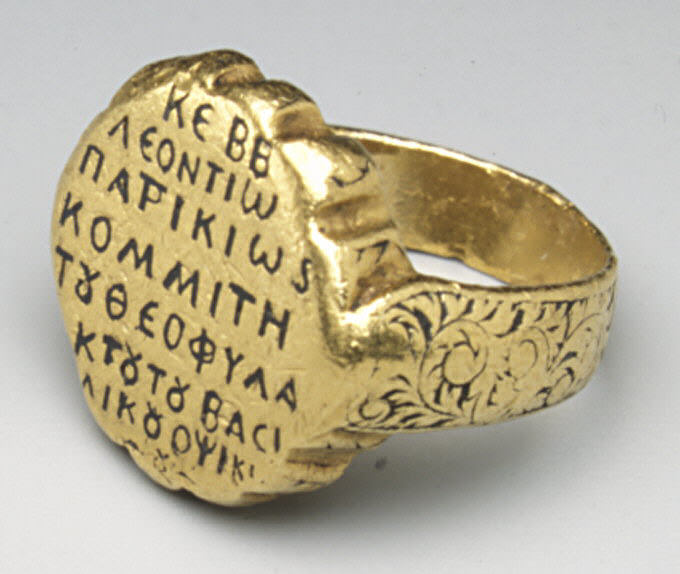
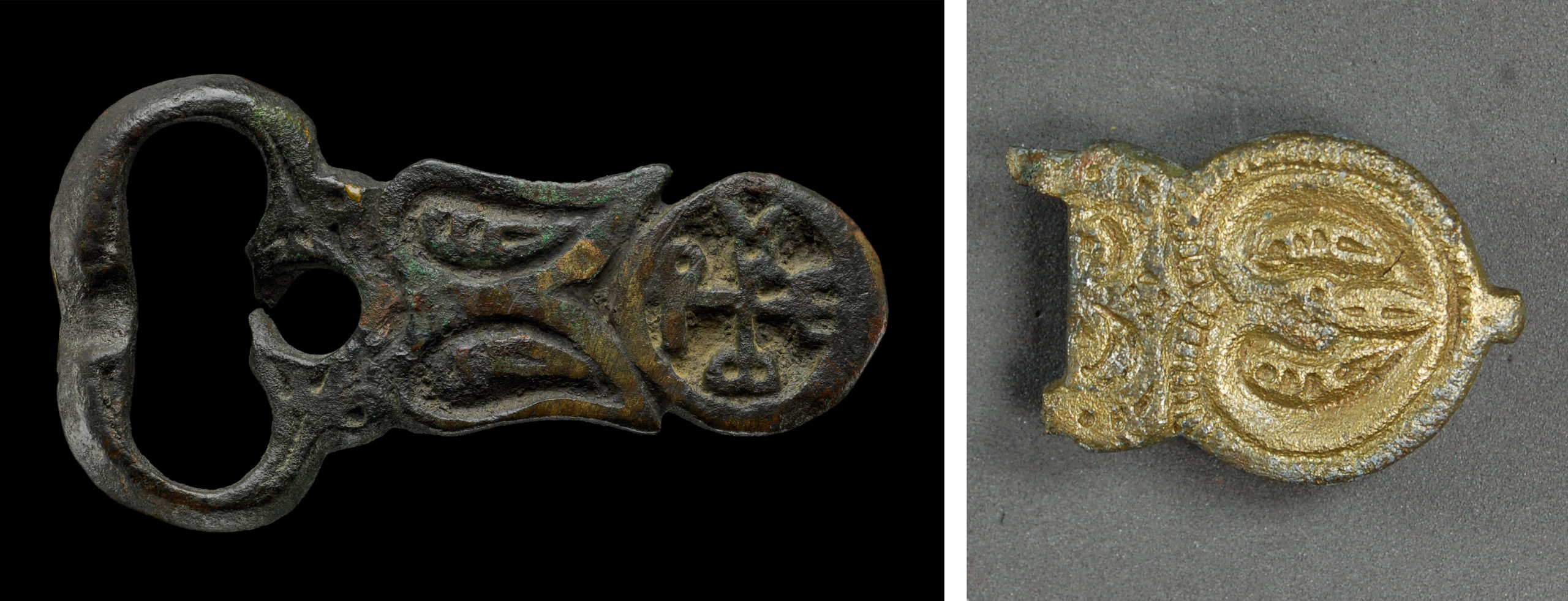
The Byzantines also made jewelry in less precious materials, including ceramic, glass, and base metals like bronze and copper. Some of these down-market items of personal adornment imitate objects in finer materials, for example, belt buckles and fibulae made of gilt-copper or gilt-bronze were burnished to appear like gold.
The combination of natural and human-made materials is also found in these less luxurious items of adornment; early Byzantine necklaces from Egypt pair amber or coral and glass.

*
*
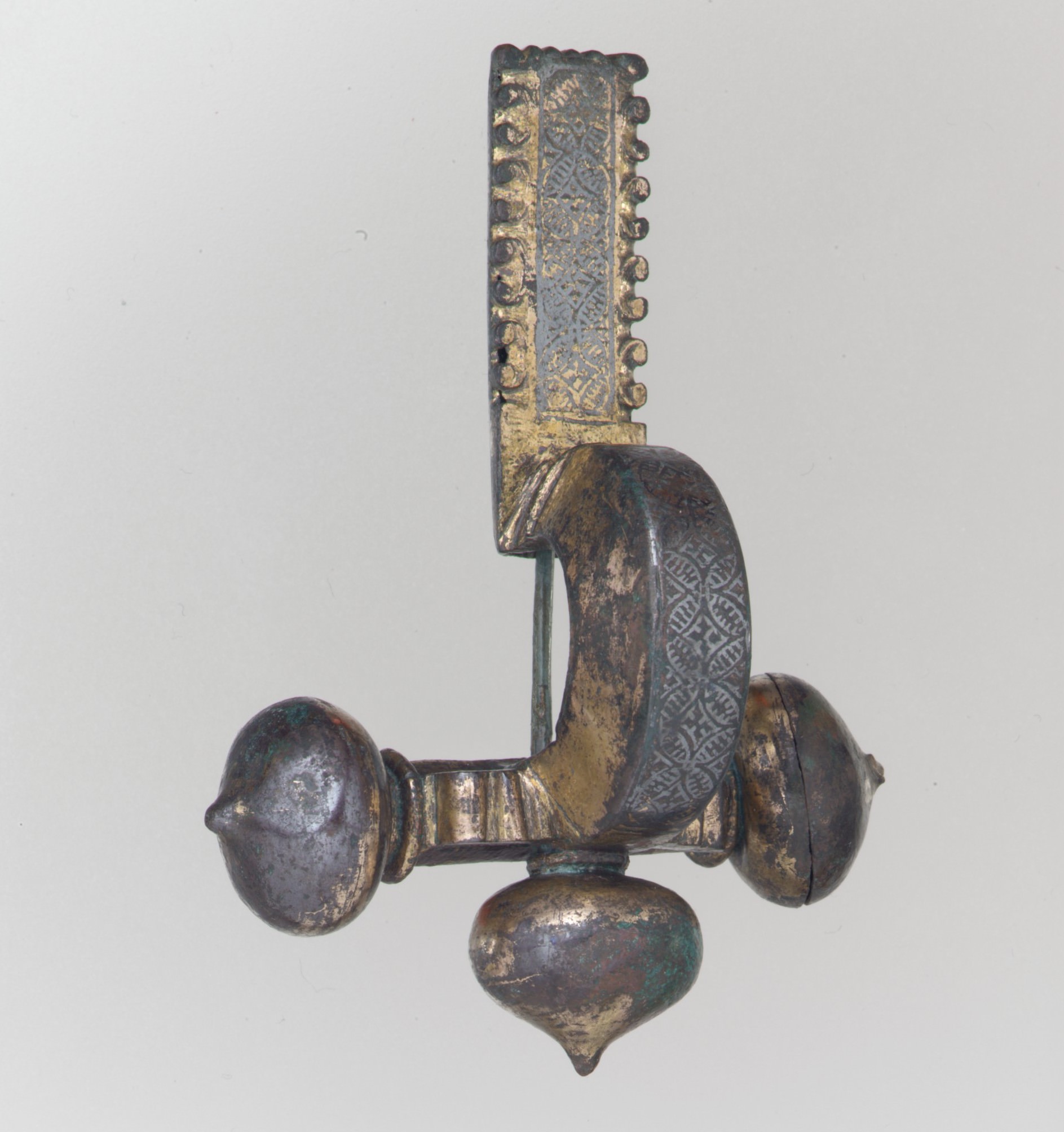
Getting dressed in Byzantium:
Garment types and decoration
The primary item of clothing in the early Byzantine era was the tunic, a sheath-like garment of simple design. Men, women, and children of all social classes wore tunics, which were initially produced in untailored form that could be adjusted to shape on the body with belts, pins, and tucks. Wool and flax (linen) were common materials for clothing of all social classes, while garments of the elite could be produced in imported materials like cotton and silk. Individuals at all levels of society embellished their clothing with decorations.
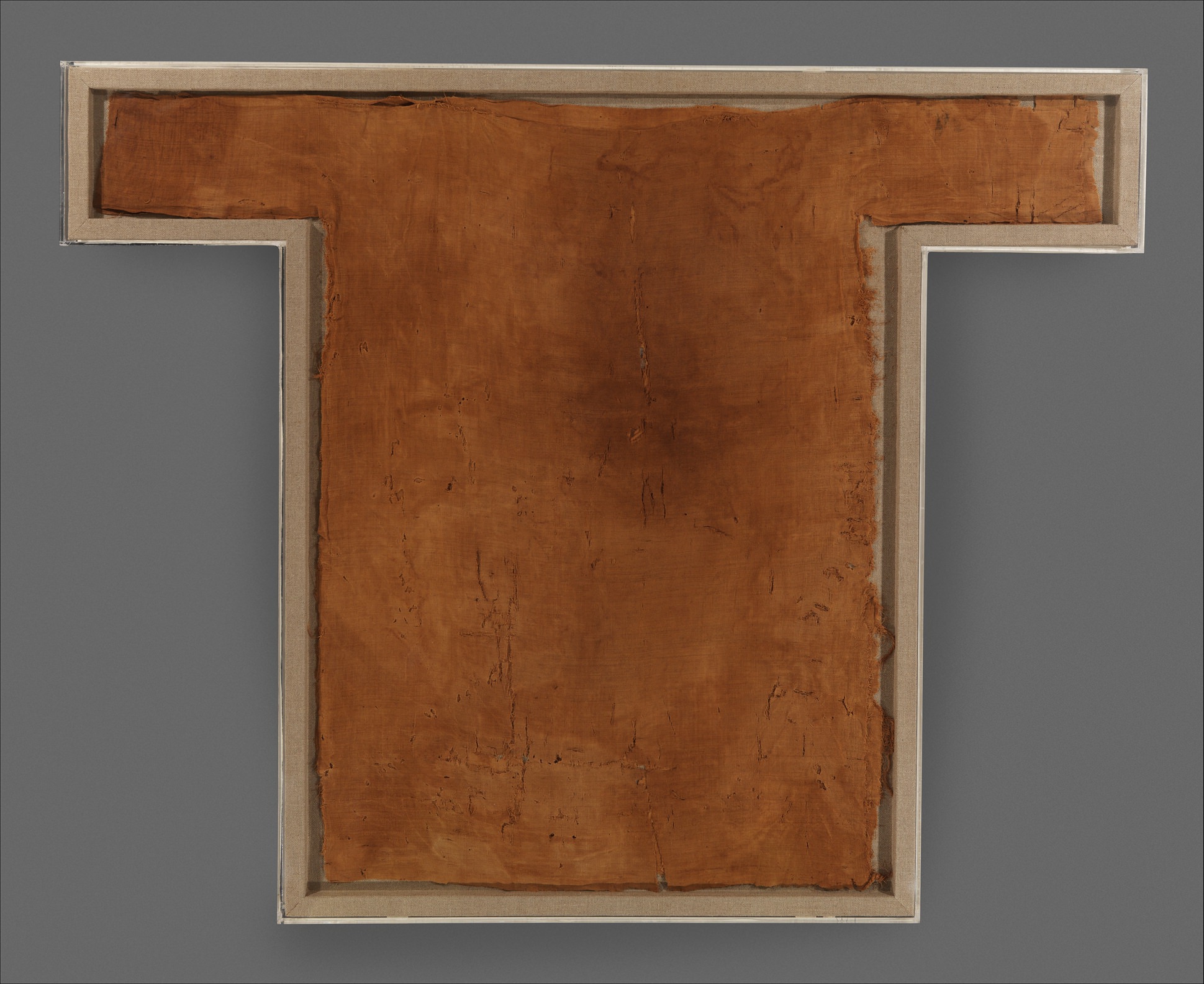
More elaborate garments depict recognizable iconographic motifs, for example, this early Byzantine tunic from Egypt decorated with vignettes of Dionysus, the pagan god of wine, and his followers. Although Byzantine society was increasingly Christianized by the fifth to sixth century when this tunic was created, Greco-Roman literature continued to be a mainstay of the Byzantine educational system until the fifteenth century, and pagan mythology was well-known, especially among the cultured elite.
Images of Dionysus were especially popular in clothing and domestic textiles, perhaps because he was associated with the pleasures of drinking, dancing, and merry making.
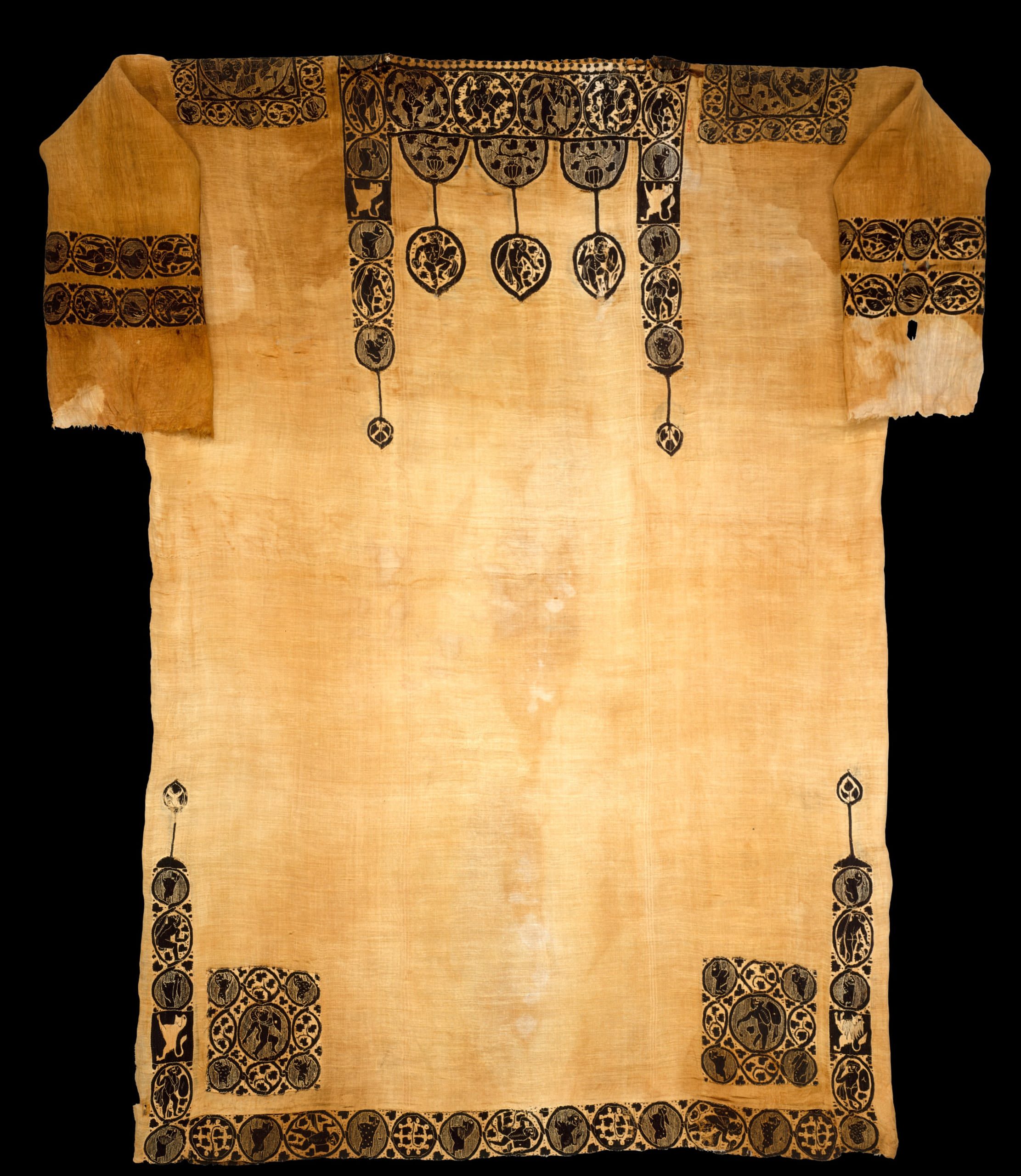
Finished garments from other cultures were also imported to Byzantium. In the early Byzantine period, Sasanian-style fitted garments were highly valued luxury objects because they were usually fabricated from precious silken fabrics and ornamented with intricate, beautiful designs. They may have also been appreciated for their tailored cut and the form-fitting silhouette it produced. Their fitted forms distin- guished them clearly from the comparatively shapeless tunics of Roman-Byzantine fashion. The emulation of foreign styles was not always condoned by Byzantine authorities. In the sixth century, the court historian Prokopios criticized young men of the capital for dressing and arranging their hair in “Persian” (i.e. Sasanian) and “Hunnic fashion.” [2]
Byzantine clothing is best preserved in the burials of late antique Egypt, where the dry climate and relatively limited degree of modern urbanization have left large numbers of late antique funerary sites and their grave goods intact. Finds from these sites show that by the fifth century, clothing of even moderately wealthy individuals adopted elaborate decorations. In-woven designs were typically rendered in wool, which took dye more easily than flax (linen). Symmetry of the body was enhanced by tunic decorations that defined the shoulders, the vertical stretch of the chest, and the length of the arms.
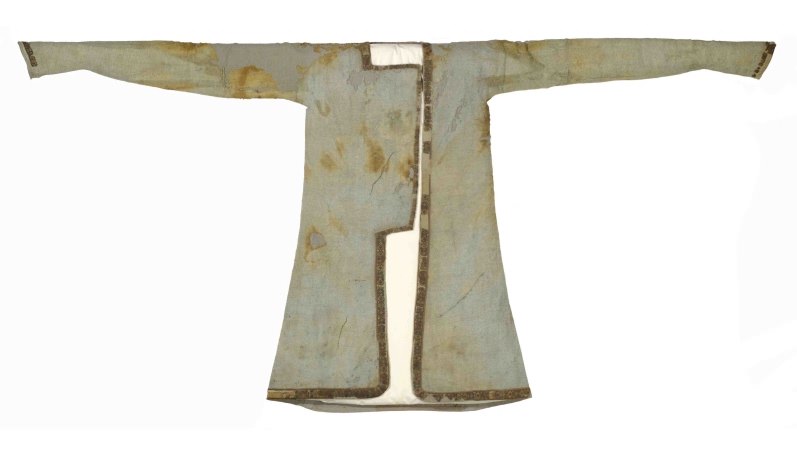
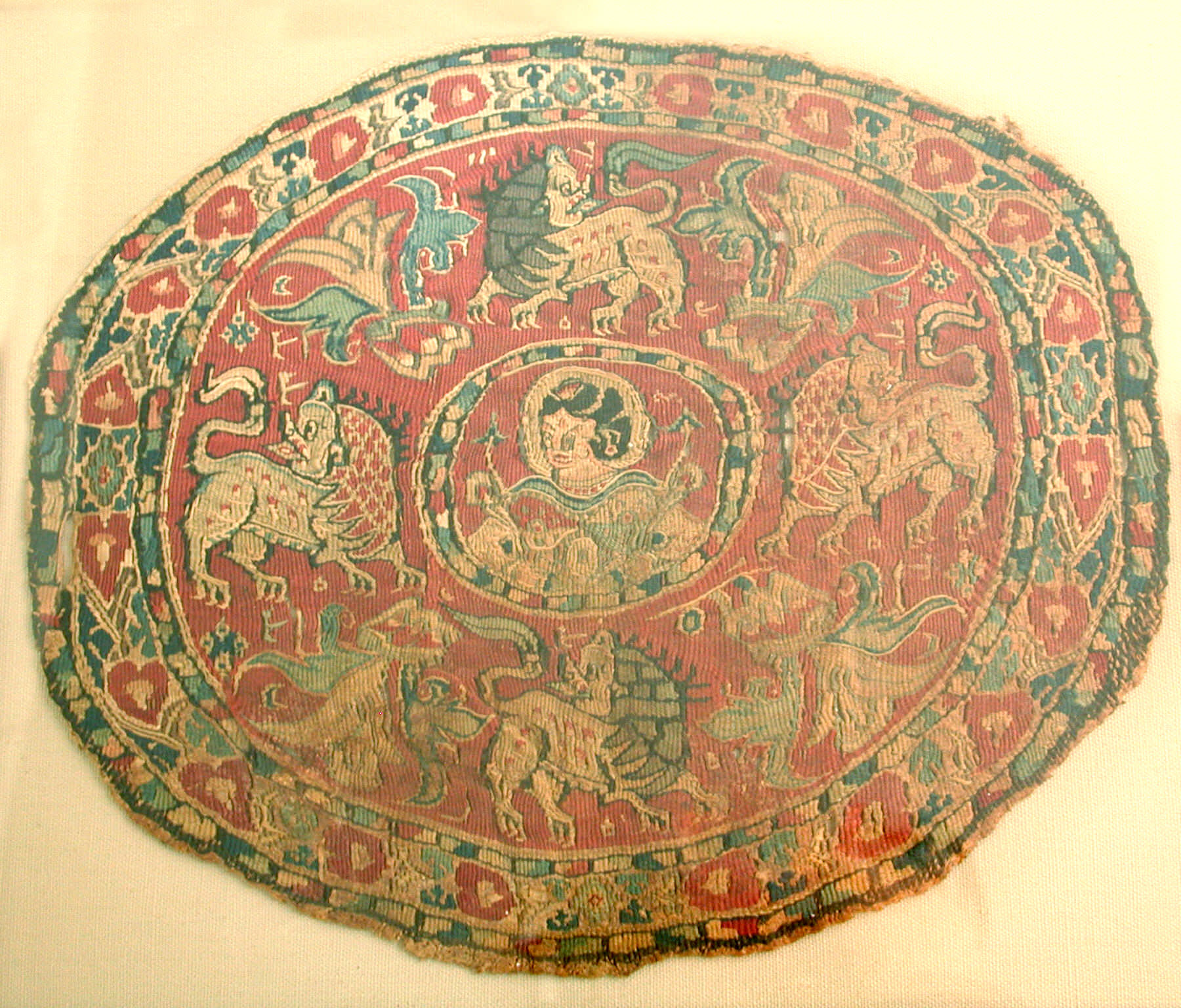
In the early Byzantine era, clothing and jewelry were decorated with a wide range of motifs. Some were primarily ornamental, such as geometric or vegetal designs. In the early centuries of Christianity, before the religion achieved widespread social and political endorsement, devotees risked persecution. Motifs that were polysemous (communicated multiple meanings) allowed the earliest Christians to avoid overt expression of their religious affiliation: only the initiated would recognize the Christian identity that these motifs conveyed. Many of these motifs continued in popularity even after Christianity became the almost exclusive religion of the Byzantine Empire.
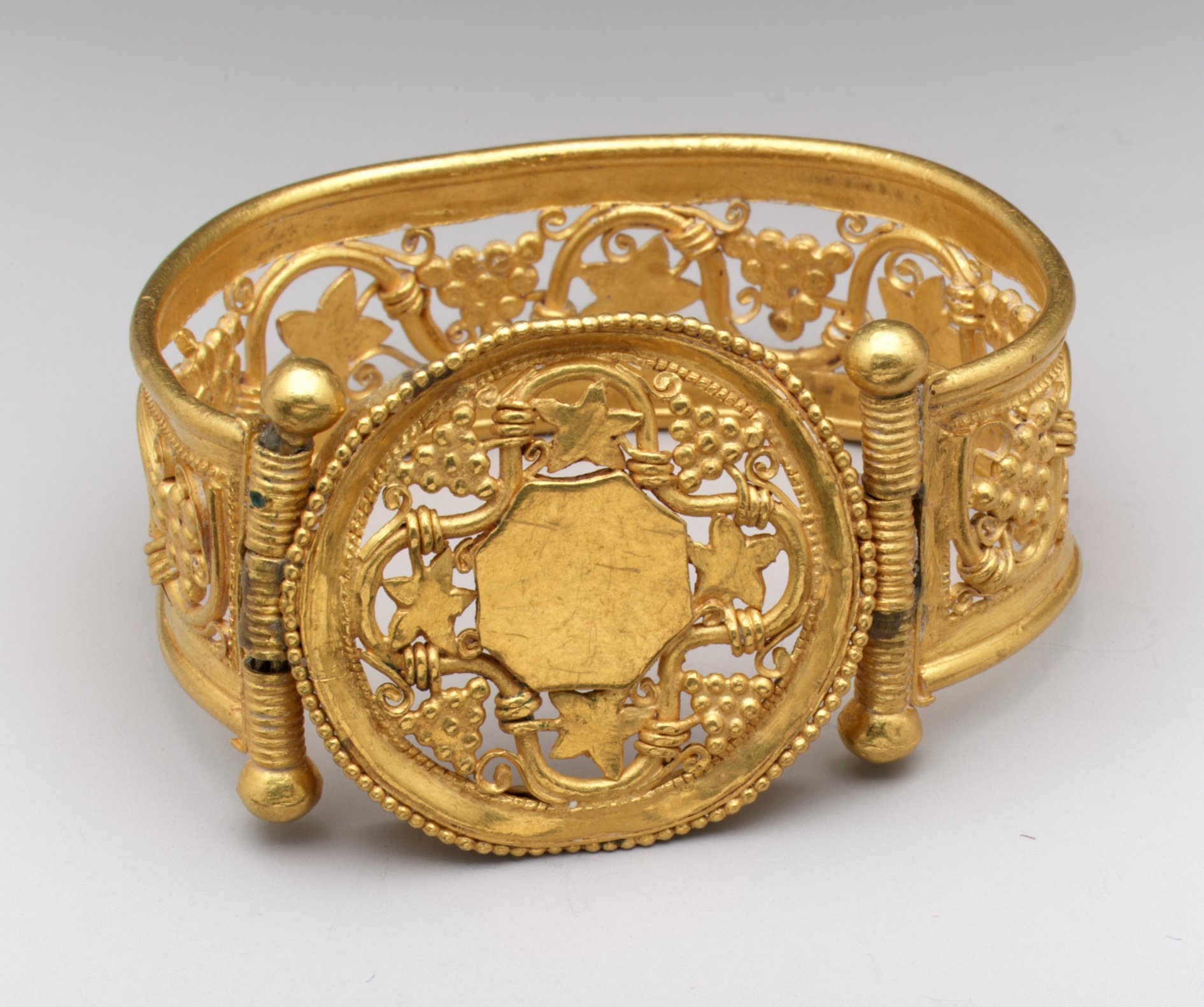
For instance, the grapevines on a sixth- or seventh-century gold bracelet (above) could be general signs of natural abundance and the good life, even an evocation of the pagan god of wine, Dionysus, or they could be understood as Christian signs that evoked Christ’s sacrifice through reference to the Eucharistic wine that was mystically transubstantiated into his blood during the Christian liturgy.
Similarly, the doves in a fifth-century opus interrasile bracelet (below) could recall the simple pleasures of nature, or they could operate as symbols for the Holy Spirit (one of the three elements of the Christian Trinity—God the Father, God the Son [Christ], and God the Holy Spirit).
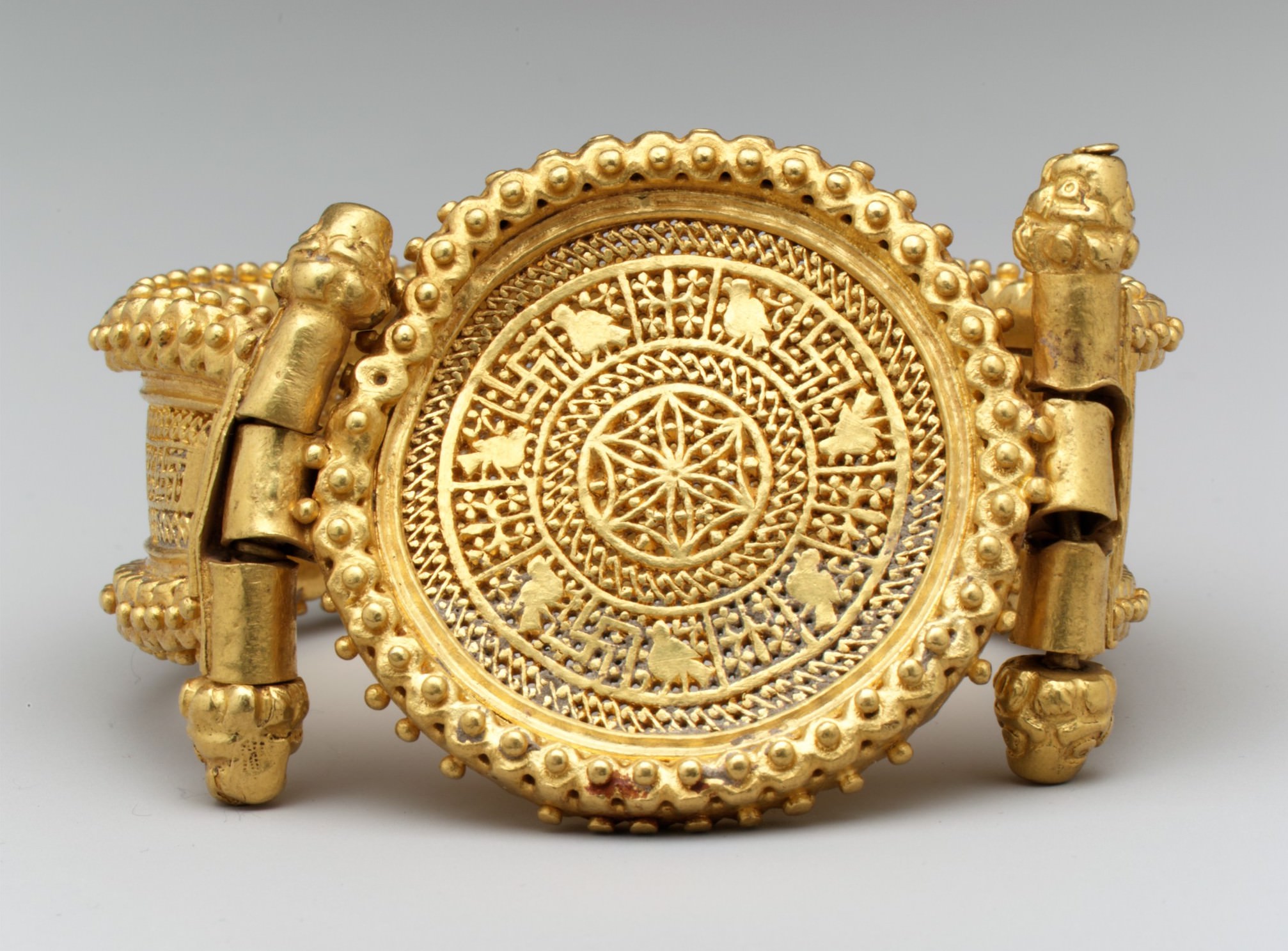
Distinctly Christian iconography became prominent by the fifth century. Crosses and images of holy people served both to identify the wearer as Christian and to facilitate prayer and protection.
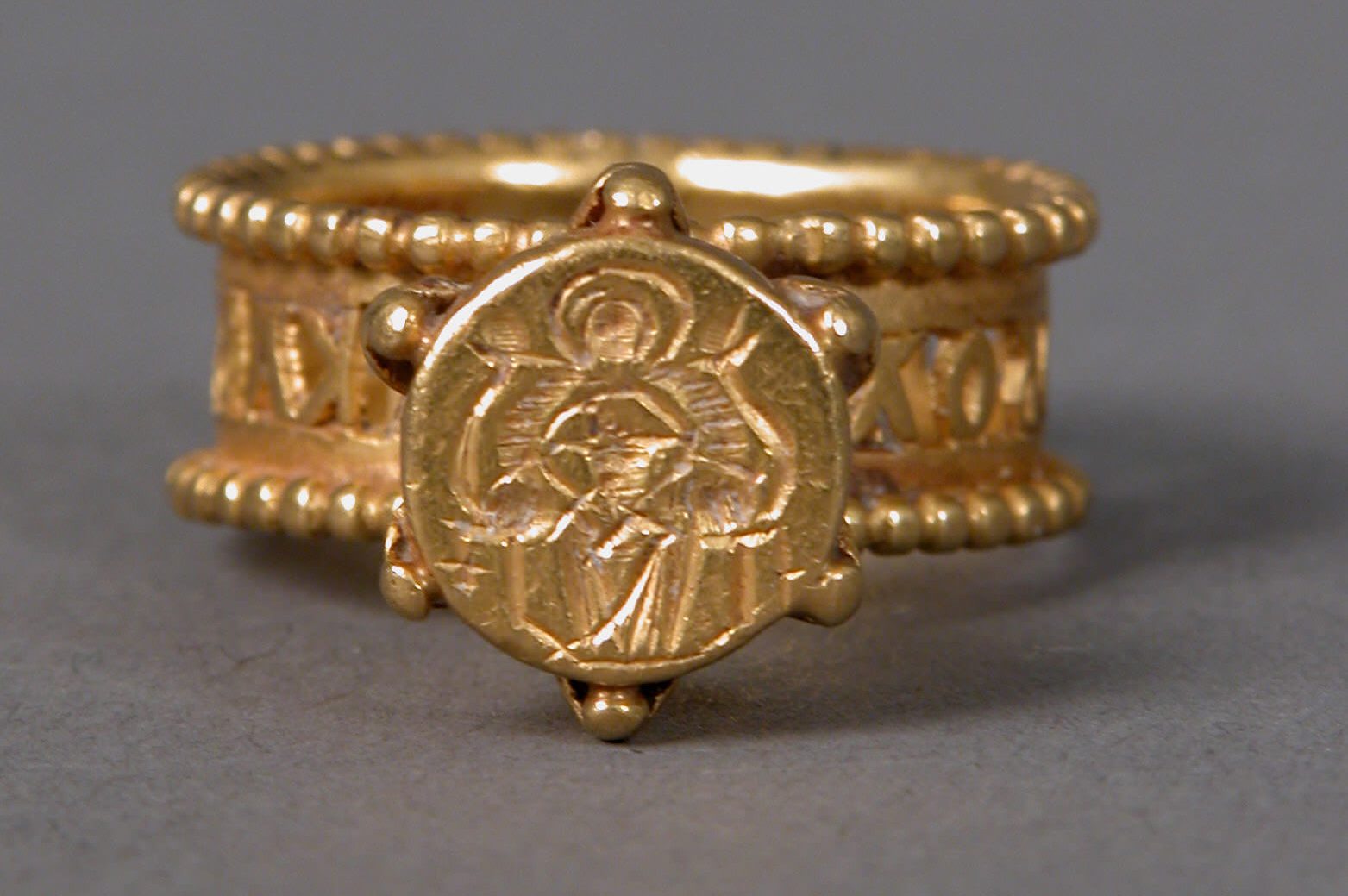
Up until the period of Iconoclasm (c. 726–843), jewelry and clothing regularly featured iconog- raphy from the pagan Greco-Roman tradition, such as images of deities like Aphrodite or Dionysus and his followers (as seen on the tunic discussed above).

Classical iconography was found on ancient gems that were reused in Byzantine works of art, like this fourteenth-century ring made in Constan- tinople and set with a Roman-era engraved nicolo stone depicting the personification Bonus Eventus (“Good Outcome”), but engraved with a protective phrase from the bible. (Personification is the human embodiment of an abstract concept; in the Roman pagan cult, personifications were worshipped as demi-gods.)
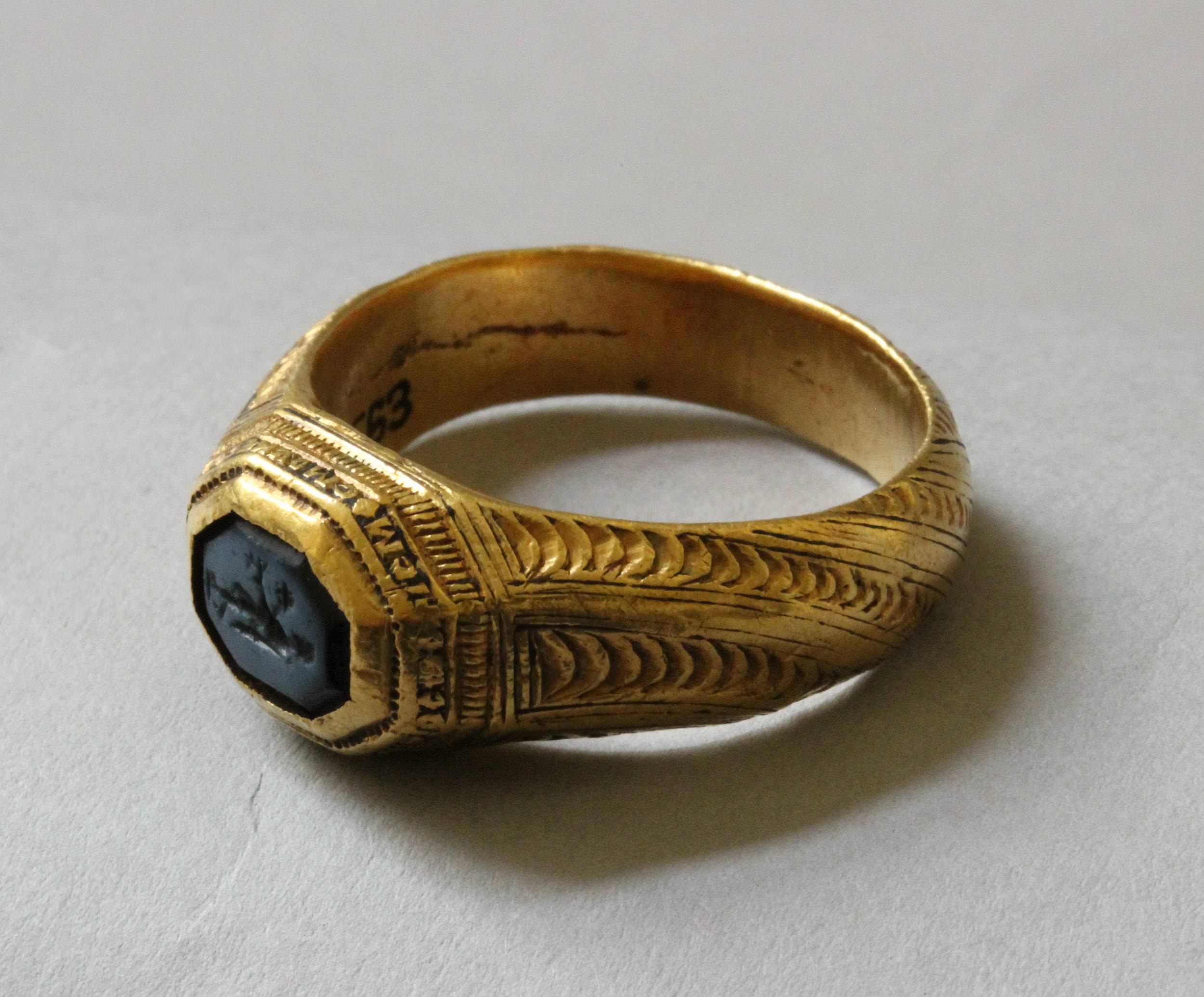
Even after pagan cult practices were largely repressed and the majority of the Byzantine population had converted to Christianity, Greco-Roman iconography persisted as an emblem of paideia, serving to affiliate the owner or wearer of an object with the classical learning and cultural refinement that medieval Byzantines continued to associate with Greco-Roman antiquity. (Paideia refers to the Greco-Roman tradition of education that the Byzantines inherited.)
After Iconoclasm, as Christianity fully dominated Byzantine society and pagan mythological iconography was no longer common in objects worn on the body, protective motifs that originated in antiquity still endured, bearing witness to the survival of pre-Christian traditions. For example, the so-called Evil Eye (which protected the wearer from the envy of others), the Holy Rider (who was thought to be powerful against demons and other evil forces) and the Chnoubis (a magical motif that was believed to be especially effective against headaches and ailments of the uterus) can be found in medieval—and even modern—amulets, as illustrated here.
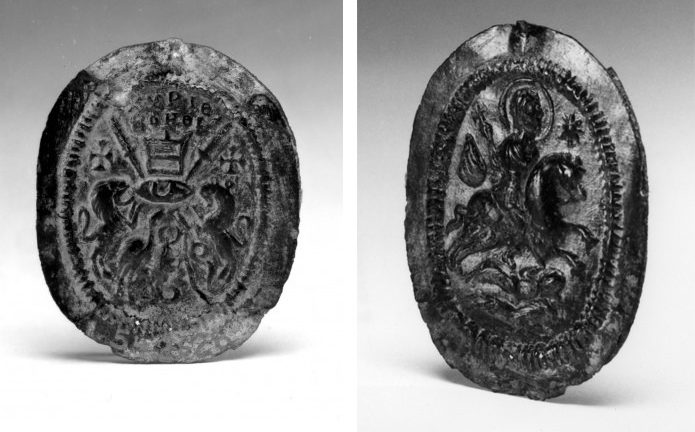
Christian motifs also functioned as amuletic devices to protect or heal through their materials and iconography. An elaborately engraved early Byzantine amulet depicting the Woman with the Issue of Blood is inscribed with an abbreviation of the relevant biblical passage (Mark 5:25-34). It was intended to cure its owner, who presumably suffered from a similar ailment. The object’s material, hematite, was believed to staunch the flow of blood, and the image would have operated sympathetically, healing the owner of the amulet (who is possibly represented in the praying figure on the reverse) just as Christ healed the woman who sought his aid. [3]
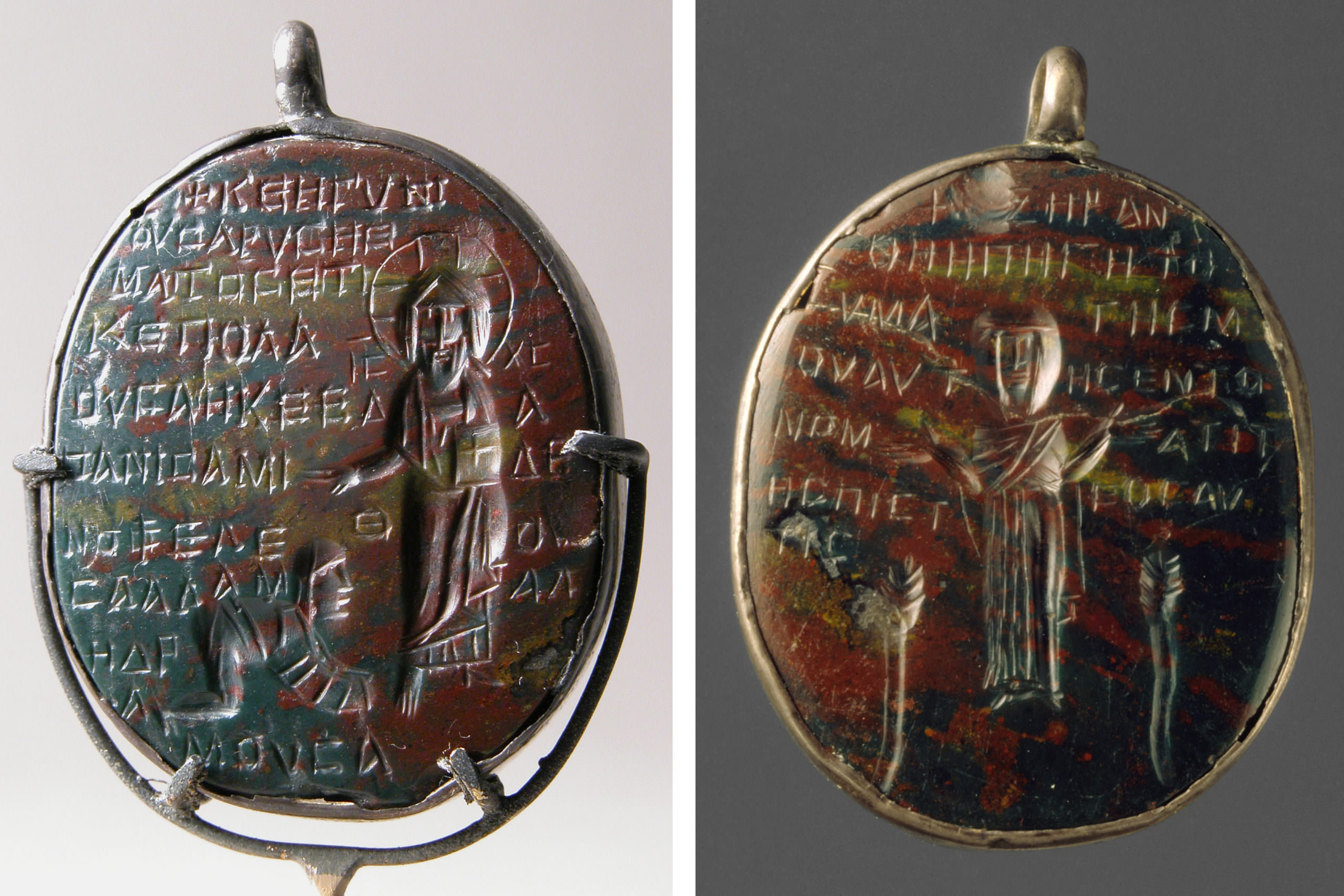
In the Middle Byzantine era, a common item of wearable art was the pectoral cross, a pendant cross worn on the chest. Bronze examples are attested in large numbers, as seen with this Pectoral Cross-Shaped Reliquary with Saints. They are decorated with inscriptions and images, often crudely executed. [4] Constructed from two parts held together by a hinge and pin, the crosses could be opened and filled with holy substances, including relics and contact relics.
More luxurious pectoral crosses might be made from precious metals or enamel. Over the course of the Middle Byzantine era, enkolpia (pendants worn on the chest, usually decorated with sacred imagery and used in personal devotion) became an integral part of personal devotion and were closely aligned with an individual’s identity. Some examples were made from luxurious materials—including gold, enamel, pearls, and precious stones—and they were inscribed with prayers for the salvation and defense of the owner.
An especially elaborate enkolpion depicts Saint Demetrios (obverse) and the soldier martyrs, Saints Sergios and Bacchos (reverse). A pin at the top can be unscrewed, allowing the container to open. Inside two doors are revealed behind which reclines a miniature effigy (a representation of a specific person, typically in sculptural form) of the saint that likely references his pilgrimage shrine, which was thought to be a site for miracles. An inscription on the edge of this object indicates that it once held a blood relic of Saint Demetrios along with the contact relic of the miraculous balm (oil) excreted at his tomb: “The faith of Sergios [the owner] carries the venerable receptacle of Demetrios’ blood together with the balm. He asks to have you as protector, while he is living, and when he is dead, along with the two martyrs who have won the prize.”
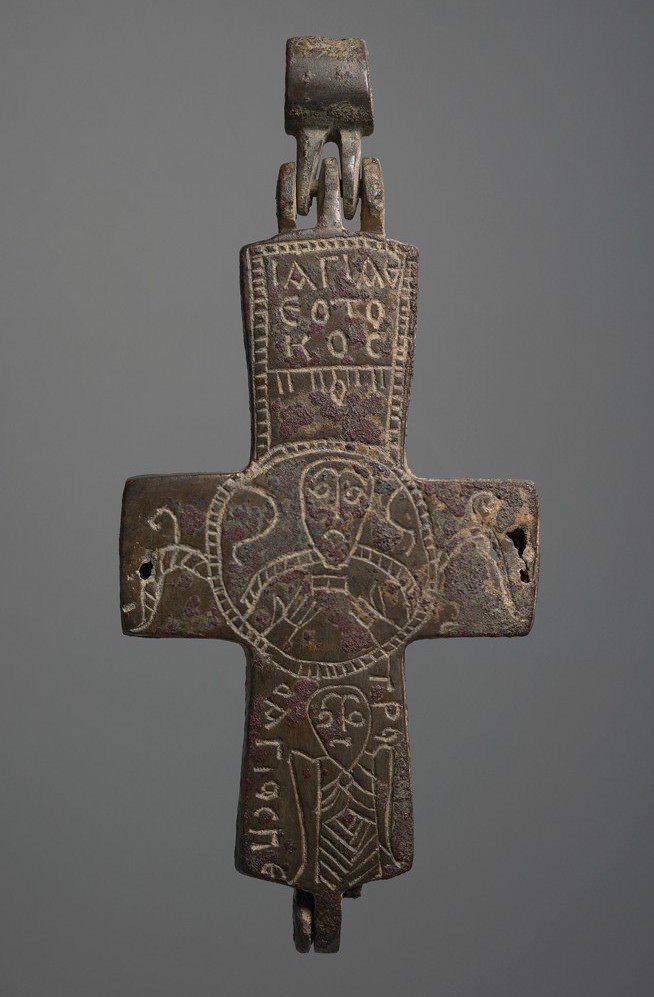
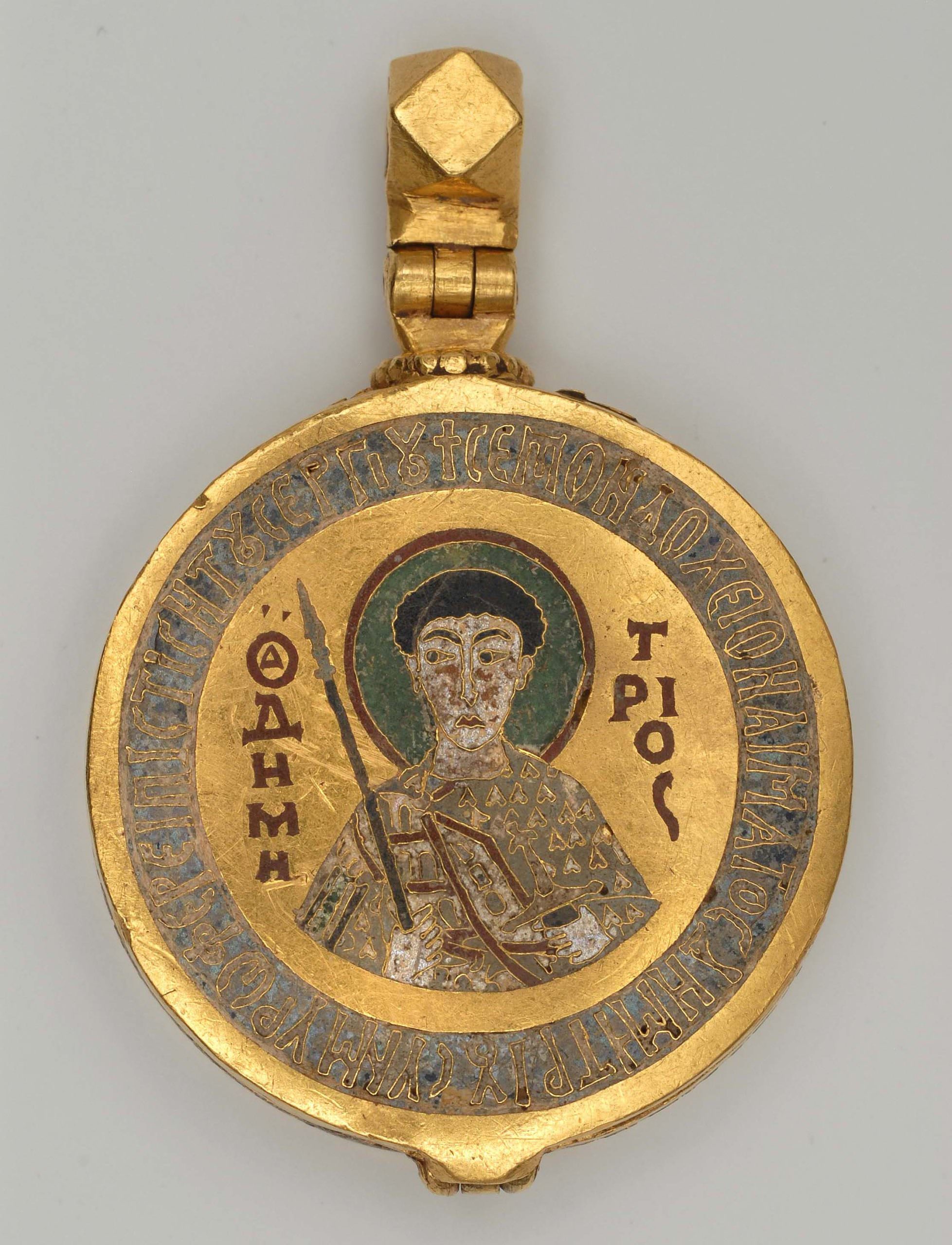
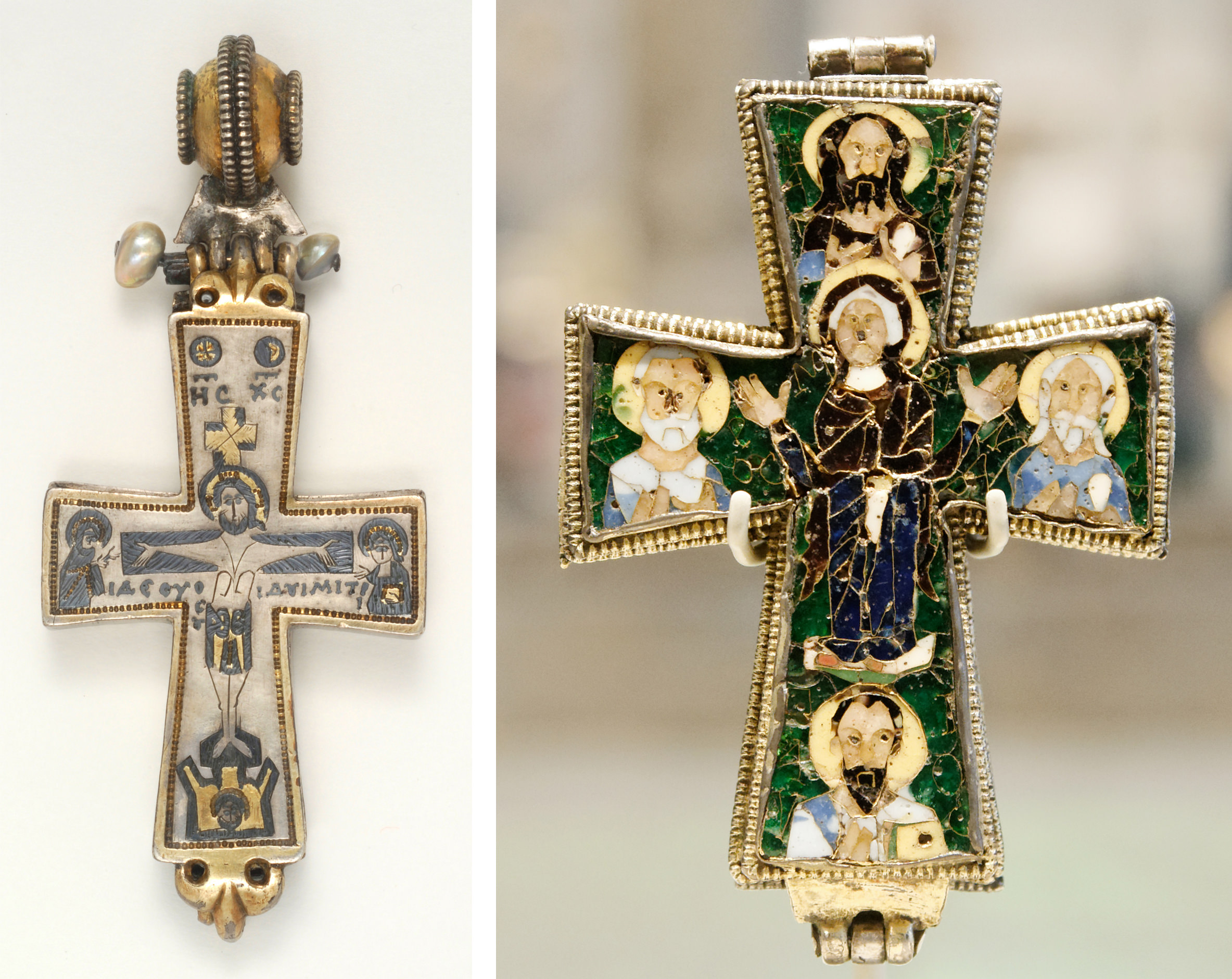
Throughout Byzantine history, personal adornment was often contested by Christian commentators, who associated elaborate jewelry and clothing with vanity and fornication. While some ecclesiastical authorities advised that the devout should adorn their bodies with only religious imagery, others criticized such practices as a form of false devotion, arguing that proper Christian behavior required the hard work of adorning the soul through good deeds rather than the quick fix of merely wearing Christian identity on one’s sleeve. Throughout these discussions it is clear that the Byzantines attended carefully to personal appearances, and the materials, motifs, and designs worn on the body were judged as a reflection of an individual’s social and spiritual character.
Notes:
[1] Myrto Hatzaki, “The Byzantine Ideal of Beauty: Definitions and Perceptions,” Beauty and the male body in Byzantium: perceptions and representations in art and text (New York: Palgrave Macmillan, 2009), esp. 26.
[2] H. B. Dewing, trans., Procopius: The Anecdota or Secret History, Loeb Classical Library 290 (Cambridge, MA: Harvard University Press, 1935), 78-81.
[3] The New Testament recounts among Christ’s miracles the healing of a woman who suffered from a persistent gynecological ailment that caused her to bleed uncontrollably. She had sought remedy for her condition from all available sources, but unsuccessfully. Because menstrual blood was considered unclean, her illness would have also caused social ostracization. Moved by her faith in Christ’s power to heal, she approached him from behind and touched the hem of his garment. Upon contact, she was relieved of her illness. For the amulet see Jacquelyn Tuerk Stonberg, “An Early Byzantine Inscribed Amulet and Its Narratives,” Byzantine and Modern Greek Studies (1999): 25-42.
*
[4] Brigitte Pitarakis, Les croix-reliquaires pectorales byzantines en bronze (Paris: Picard, 2006).
Additional resources
Christopher Entwistle and Noël Adams, Intelligible Beauty: Recent Research on Byzantine Jewellery (London: British Museum, 2009).
“Gold Jewelry Technique: Wire,” The Metro- politan Museum of Art
<https://www.metmuseum.org/metmedia/video/collections/asian/gold-jewelry-technique-wire#>
“Gold Jewelry Technique: Granulation,” The Metropolitan Museum of Art
<https://www.metmuseum.org/metmedia/video/collections/asian/gold-jewelry-technique-granulation>
Quinn Hargitai, “The strange power of the ‘evil eye,’” BBC, February 19, 2018
<https://www.bbc.com/culture/article/20180216-the-strange-power-of-the-evil-eye>
Brigitte Pitarakis, “Objects of Devotion and Protection,” in Byzantine Christianity, edited by Derek Krueger and Denis R. Janz, A People’s History of Christianity 3, 164-81 (Minneapolis: Fortress Press, 2010).
<https://www.metmuseum.org/toah/hd/popu/hd_popu.htm>
Thelma K. Thomas, ed. Designing Identity: The Power of Textiles in Late Antiquity (Princeton: Princeton University Press, 2016)
Alicia Walker, “Bodily Adornment in Byzantium: Objects and Images,” in The Oxford Handbook of Byzantine Art, ed. Ellen Schwartz (Oxford: Oxford University Press, 2021)
Warren T. Woodfin, The Embodied Icon: Liturgical Vestments and Sacramental Power in Byzantium (Oxford: Oxford University Press, 2011)
